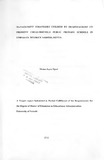| dc.description.abstract | While trying to harmonize basic primary and secondary education, Kenya faces the challenge of providing a Child-friendly school (CFS) environment that will ensure child-centered and rights-based teaching methods and a qualitative education that is capable of producing healthy, creative, and confident and peace loving citizens. MoE in conjunction with UNICEF came up with a toolkit which provides a framework for policy makers and educational practitioners at all levels on how to promote CFS in the country. The purpose of this study was to investigate the management strategies utilized by headteachers to promote child-friendly public primary schools in Embakasi District, Nairobi County.
The study addressed five objectives which were; to establish the level to which the headteachers' preparation for teachers has promoted child-friendly public primary schools, establish how the headteachers' involvement of parents and community has influenced promotion of childfriendly public primary schools, investigate the extent to which the headteachers' mobilization of the physical facilities has influenced promotion of child-friendly public primary schools, determine the extent to which the headteachers' provision of security has promoted child-friendly public primary schools and to investigate the challenges the headteachers encounter in their attempt to promote childfriendly public primary schools in Embakasi District, Nairobi County and how they address the challenges .
The study was conducted using descriptive survey design and it targeted twenty public primary schools in Embakasi District. The study used Krejcie and Morgan's table to determine sample sizes for the teachers and simple random sampling for pupils. Headteachers were sampled through purposive sampling while the schools were selected through random sampling. The study was guided by the goal setting theory which was used to investigate the specific objectives and measures the headteachers have taken to promote child-friendly public primary schools.
The researcher used questionnaires for the respondents and an observation schedule for the researcher. The validity and reliability of the instruments was checked by the supervisors and other experts in education administration department. The researcher conducted a pilot study in 2 of the 20 schools where the responses yielded a co-efficient of 0.724 by use of Pearson's Moment of Coefficient and then the split half technique was employed to ascertain the internal consistency of reliability. Descriptive statistics was used to analyze quantitative data by calculating frequencies and percentages hence represented by means of tables, graphs and charts. Qualitative data from open-ended questions was thematically presented in narrative form and tables. The observation schedule was analysed thematically and by use of photographs which were taken to illustrate the situation of the infrastructure in the schools in Embakasi District.
The findings of the study revealed that majority of the headteachers had done fairly well to promote child-friendly public primary schools in Embakasi District. They had put in place several strategies to enhance promotion of childfriendly schools in their respective institutions. These strategies included support and preparation for the teacher, parent and community involvement, mobilization of infrastructure and provision of security which had contributed to promotion of child-friendly public primary schools. However the researcher noted that some headteachers had not done much to make their schools child-friendly hence, headteachers needed to spearhead the initiative by putting in proper strategies and ensuring proper supervision is carried out at the school level.
Based on the findings of the study, the researcher noted that promotion of childfriendly public primary schools by the headteachers was facing a number of challenges such as resistance to change mostly among the teachers, inadequate sensitization among teachers and parents, uncooperative parents, low funding, hostile school neighboring communities among other issues. However majority of the targeted headteachers had taken every available opportunity to make their schools child-friendly. | en_US |

